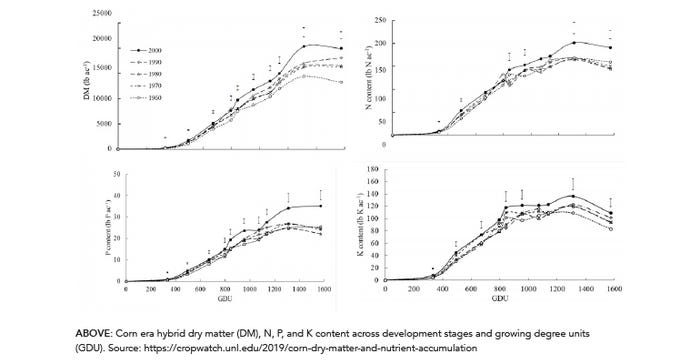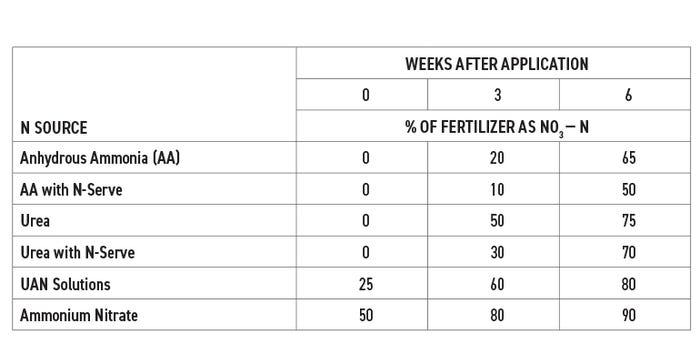December 1, 2020

Sponsored Content
German chemist Justus von Liebig is often credited with ushering in the modern era of soil chemistry and plant nutrition. In the mid-1800s, von Liebig’s’ research and discovery led to the development of the first nitrogen-based commercial fertilizer. Since then, soil scientists and agriculturalists around the world have endeavored to understand and manage the use of these fertilizers in corn production. Managing nitrogen (N) for corn production is a difficult task due to the complexities of the nutrient and the hundreds if not thousands of factors that influence N in the soil and in plants.
One major factor that has caused a shift in the way N is managed is how modern hybrids utilize N. Since the mid-2000s, new hybrids that have been developed and brought to market show a trend of a greater percentage of total N uptake that has shifted later in their growth cycle. This change in uptake characteristics suggests that having sufficient N available to the plant post silking can lead to higher overall grain yields and increased stay green in the plant. When the corn plant can assimilate new N for supplying N for grain fill, the plant does not need to remobilize as much N as early in the maturation process, leading to increased plant health characteristics (below).

Because of the increase of grain yields with the advancement of new hybrids, the Nitrogen Use Efficiency (NUE) of modern hybrids has increased over time. With the understanding that most new hybrids are trending to later-season N uptake and better NUE, our N management plans should be tailored to meet the need of the hybrids.
Another thing to consider when managing hybrids and N programs knowing that the plants are generally up taking N later in the season, is to pay special attention to the availability of the N source that is applied. Corn can utilize N from the soil in two forms, ammonium (NH4 +) and nitrate (NO3 -), with nitrate being the main form taken up. With different N fertilizers having vastly different chemical properties and forms, the timing of nitrate availability will differ. Refer to the chart for a quick reference on when different N sources may be available to the crop. The chart is a great reference, but temperature, rainfall, soil moisture, and soil type will all influence the timing of availability.

Advancements in N utilization and management have not fallen solely on hybrids and understanding soil characteristics. Over the past few years, there have been considerable advancements in products and practices that promote the reduction in overall N usage (per acre) with microbial amendments to fertilizers. The goal of these products is to colonize the root zone of corn plants and expand as they grow, providing the plant with N that is cycled through the microbes. These products are currently being studied through Beck's Practical Farm Research (PFR)® program, and the results will be released soon in Beck’s 2020 PFR Book! The fertilizer industry has been active in developing new stabilizers for different forms of N as well. New coating for urea helps reduce the risk of volatility and slows the release of the N, leading to availability later in the season and less risk of loss. There are multiple different products in this arena, and a careful review of each should be done before selecting the right product for your N management plans.
Technology for N management has also advanced in the N modeling platforms and the introduction of “Crop Canopy Sensor Based Management.” Sensor-based approaches use drones or other aerial imagery to measure the “greenness” of the crop. Because stressed plants tend to reflect less near-infrared and red light than a healthy plant, crop sensors can identify issues multiple days ahead of the human eye. One difficulty that remains with sensor-based N management is the inability to pinpoint the cause of stress. Similar readings to those of a N stress scan also can be observed from moisture stress and other deficient nutrient stress. Using a sensor-based approach should be a tool in the toolbox, but until further advancements are made in the technology, farmers should not rely solely on this technology for N management.
Nitrogen utilization varies greatly from year to year and field to field. Nitrogen management is an ever-moving target, but with advancement in science and technology, farmers and ag professionals are creeping closer to the elusive “right N plan.”
Beck’s is the largest family-owned retail seed company in the United States that serves farmers in Arkansas, Illinois, Indiana, Iowa, Kansas, Kentucky, Michigan, Minnesota, Mississippi, Missouri, Ohio, South Dakota, Tennessee, and Wisconsin. According to a recent seed industry survey, Beck’s ranks as the third largest corn and soybean brand in the United States. At their core, all Beck’s employees are Farmers at Heart. It stands for something special. It has soul. It has truth. And it represents a community of farmers, employees, and dealers who strive each day to seek challenges, push boundaries and innovate. Beck’s has, and always will be, proud to serve a community of farmers who love what they do and who are proud to be… Farmers at Heart. For more agronomic new and information, visit Beck’s Agronomy Talk page or blog at BecksHybrids.com.
About the Author(s)
You May Also Like




